Big Apple
Aug 9, 2009
Midtown Manhattan, looking south from the 68th floor of Rockefeller Center.
Aug 9, 2009
Midtown Manhattan, looking south from the 68th floor of Rockefeller Center.
Nov 14, 2009
Early in the morning of June 19, 2002, the Landsat 7 satellite swooped across the Indian Ocean and snapped this picture of Reunion Island. The volcano there, Piton de la Fournaise, was quiet that day--the clouds in the picture are just clouds, passing by.
Geologically, Reunion is virtually a twin to Hawaii halfway around the world, a huge shield volcano above an oceanic hotspot. It has been one of the most active volcanoes in the world throughout modern history, erupting almost every year, sometimes more than once, since 1670. The whole island is made of basaltic lava; it's the tip of a volcanic monster mountain rising from the ocean floor. All over the island are volcanic vents, cones, craters, and large calderas, where lava domes exploded and collapsed. The caldera that is currently most active, toward the top of this picture, has slumped down all the way to sealevel at the coast.
Basaltic rock weathers to make rich soil, and here as in Hawaii the climate encourages lush vegetation. New lava doesn't remain bare rock for long.
Politically, Reunion is part of France; because of its time zone far to the east of Europe, the euro became legal currency here a few hours before it did anywhere else. Eight hundred thousand people live on the island.
Nov 23, 2009
Last year, when this picture was taken, twenty million people lived in Shanghai. There are more now.
Dec 2, 2009
This salt marsh at Seabrook, New Hampshire, is now the backyard of a nuclear power plant. When this area was first settled, the marsh was the town hayfield, cut over every August or September for animal bedding, mulch, banks of insulation against the sides of houses, and packing material for shipping fruit, pottery, and other fragile items, back before foam peanuts and poppable plastic. After cutting, the grass was left in the marsh till wintertime, when the frozen mud would support the weight of horses to haul it out. If hay was needed before winter, horses could be driven in on unfrozen marshland by equipping them with huge wooden shoes that spread their weight.
But in the twentieth century, when marsh grass began to lose its value as a cash crop, the marsh was regarded as a nuisance. Drainage projects were expensive, but they were often justified on public health grounds, as mosquito-control measures. The Seabrook marsh, like many, was "ditched" with narrow little canals to dry up mosquito habitat. The project failed because the ditching destroyed habitat for important species of mosquito-larvae-eating fish.
Nowadays, we are beginning to understand the critical importance of marshes and other wetlands, for wildlife, storm-buffering, and many other functions. A handful ofl New England marshes have been restored to something approaching their pristine condition. And many others, including Seabrook, are slowly recovering thanks to protective legislation.
The mosquitoes are not an endangered species.
Dec 6, 2009
On a clear night, Chicagoland looks pretty spectacular from the air.
Jan 4, 2010
This birdseye view of the town of Biratnagang, Nepal, was captured from ?????
Jan 11, 2010
When they built the Grand Trunk line from Portland to Montreal in the early 1850s, they had to figure out a way over or around the White Mountains in New Hampshire. They ran the tracks up the Androscoggin River valley past the tiny village of Gorham, just eight miles north of 6,200-foot Mount Washington. Gorham became the railroad maintenance and service center, and this late-nineteenth-century birdseye view of Gorham shows the extensive railroad yards developed there.
Anyone who has been to Gorham, however, will notice something a little odd about this image of the place. The mountains in the background look low and unprepossessing, just some handsome, rolling topography off in the distance. Actually, they loom crazy big over the town, with Mount Washington in particular filling the sky and dominating the view almost like an Alp. Gorham is less than 800 feet above sea level; the peak of Mount Washington is more than a mile higher. Perhaps the artist (and/or his patrons in town) feared that big mountains might scare people away from Gorham. Gentle country would look more hospitable.
But the railroad that created Gorham eventually brought tourists to the hills, and today the town survives as a jumping-off point for vacationers in the White Mountains. An artist publishing a twenty-first-century birdseye view of the town would probably want to emphasize the mountains, maybe even drawing them bigger and steeper and closer than they really are. Wild, dramatic country is what the people want nowadays.
Trains don't stop here any more, but there is a railroad museum.
Jan 28, 2010
A few months ago, the New Zealanders among us were out touring their island--New Zealand's North Island--when they stopped for the night at the Okopako Farm Lodge in Opononi, Northland, a backpackers' hostel at the end of a primitive gravel road--a road so narrow and winding and twisty, we're told, that it can't be driven after dark. The people who run the lodge, which is off the electrical grid, offer "fresh organic produce, homemade bread & farmhouse meals," and they also promise a nice view.
This is what dawn looks like from the deck of the lodge.
"I shot photo after photo," recalls A., "as the sun rose. Unfortunately, I was so engrossed in the scenery I left bread on a burner on one of those camp toasters until it thoroughly burned, and its blackened remains released a massive amount of smoke that set off the fire alarm. The fire alarm rang for about 20 minutes, which did not thrill the few other inhabitants of that place.
"The upside was that they were awakened in time to enjoy the sunrise, too."
Feb 18, 2010
Fitzrovia is the London neighborhood that once surrounded the Fitzroy tavern, a long-gone, between-the-wars watering hole. Plenty of pubs remain, however, and for generations now, Fitzrovia might be best characterized as the part of town where famous writers and musicians go to drink: the long list is known to include George Orwell, Virginia Woolf, Dylan Thomas, Rimbaud, Verlaine, and more recently, Bob Dylan, Pink Floyd, and the fictional heroes of Saul Bellow.
Feb 27, 2010
Looking southward down Manhattan from the top of 30 Rock, toward the Empire State Building and beyond. That's the Verrazano Narrows Bridge near the top of the photo, connecting Brooklyn and Staten Island.
Mar 17, 2010
Last week, the Gowanus Canal in Brooklyn was named a Superfund site, meaning that umpteen million dollars will be poured into cleaning up its pollution. Gowanus water has been sludged with grease and foul-smelling nastiness for a long, long time--so long, in fact, that hardly any new buildings have been constructed in the neighborhood since the nineteenth century.
This painting was recently submitted to the New York Times by an anonymous artist, in response to a call for works remembering the canal and its neighborhood. In this scene, the neighborhood looks bright and vibrant. "The artist's eye can find something special in this unlikely place," noted one New Yorker. "But if you've been there, you know it by the smell."
"And the noise!" observed another. "Lots of old Italian men screaming words of torment and threat into the night, muttering something about busting someone’s head off with a baseball bat."
"This reminds me of the old joke," said a third. "Guy asks, 'What's the quickest way to the Gowanus?' The answer is: 'Borrow five hundred dollars from Dominic and don't pay him back.'"
May 16, 2010

Last week, a new condo tower opened in Philadelphia near Rittenhouse Square; its penthouse has already been sold, for $12.5 million. This picture was snapped by a glazier who was hired by the new owners to redo some of the windows.
This is only a small part of the view that $12.5 million buys. The penthouse occupies one entire floor of the new building, and its views are 360 degrees. What you see here is the view looking to the east: the art deco Medical Arts Building across the street, the vaguely Moorish Drake tower near the righthand edge of the photo, with the new glass quonset-hut-canopy of the Kimmel Center behind it.
In the distance is New Jersey, on the far side of the Delaware River.
By all accounts, the new condos are pretty nice. Each one occupies an entire floor, with elevators that are basically private for each resident. In the elevators are buttons you can push to operate the fully automated underground garage; your car will be whisked up from its underground spot and placed gently near the street-level exit, all ready for you to slide behind the wheel and venture forth into the city.
May 24, 2010
The Bestiboka River reaches the sea in the Mozambique Channel, along the northwestern coast of the island of Madagascar. There at the mouth of the river, ocean tides push saltwater upstream, slowing or even halting the downstream flow of the muddy river water; wherever the river pauses, sand and silt drop to the bottom of the bay, piling up into sandbars and islands.
In Madagascar's tropical climate, new sandbars quickly acquire a fringe of bright green mangrove scrub, which stabilizes the sediment and also shelters baby shrimp and other aquatic critters. Bombetoka Bay, the estuary here, is highly productive, especially for shrimp. The rectangular pens near the top of this picture are commercial shrimp farms.
The mangrove swamps along the lower reaches of the river trap vast quantities of sediment pouring down from upstream, which keeps the water clean and free of mud as it enters the bay; without this mangrove filtering, Madagascar's huge coral reefs just offshore (off the top edge of this picture) would soon die, smothered by sand.
May 29, 2010
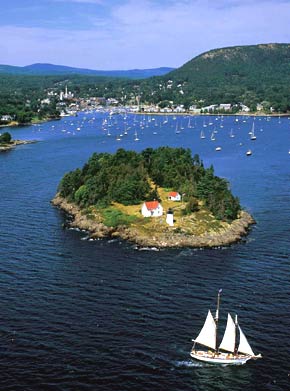
This birdseye view of the harbor at Camden tells the seasonal story all up and down the coast of Maine. The boats are back.
Jun 11, 2010
Last week, a NASA satellite flew over South Africa so its sensors could snap this picture of the soccer stadium, known as Soccer City, where World Cup action begins today.
The stadium itself is the white rounded rectangle in the upper right corner of the image. The three big grayish things in the middle are slag heaps, the rocky refuse of more than a century of gold-mining activity in the Johannesburg district.
At the bottom edge of the picture is part of Diepkloof, one of the neighborhoods of Soweto. When Nelson Mandela was let out of prison in 1990, he made his first public appearance in the Soccer City stadium. In this same stadium today, the South African national team challenges Mexico in the opening game of the FIFA World Cup; sadly, Mandela, once a soccer player himself and a lifelong sportsman, is said to be too frail to attend. He is 91 years old.
As this posting goes to, um, press, Mexico has just tied South Africa, 1-1, in the opening game.
Jun 12, 2010
The village of Stein-am-Rhein in Switzerland, as seen from its castle.
So far as I know, the Steins associated with this place have no connection whatsoever to the Steins in the family I married into. I like the looks of their town, though.
Oct 22, 2010
If you drop the first two letters of the name of the nation of Mexico, you get Xico, the name of several towns and landmarks around the country. There is, for example, the small hill town of Xico near Veracruz, where it is said that people do very little besides growing coffee and hosting bullfights. And here we see two other Xicos: a volcanic crater and the fast-growing city that surrounds it.
Xico volcano sits at the extreme southern end of the Mexico City megalopolis. For a geologically significant chunk of time, this area was underwater, drowned by Lake Chalco. The lake began to dry out in the 1300s, and Aztec fishermen settled along its coastline hereabouts. In the nineteenth century, the government drained the lake entirely; the fishermen were awarded communal land grants and told to become farmers.
Farming became intensive in the 1970s, when corporate agriculturists and desperate landless peasants struck illegal or quasi-legal deals with the communal organizations and wrested control of the rich volcanic soil. Thousands and thousands of families poured into the region, hoping for work. Farmers climbed over the rim of the volcano and plowed fields inside the crater. Xico the town sprawled right up to the ramparts of Xico the crater and appears likely to soon engulf it; in 2005, the population of the municipality was 330,000.
The urban fringes seen here lack the services and amenities taken for granted twenty miles away in downtown Mexico City. Xico's roads are mostly unpaved, schools are few and far between, and the people are almost all very poor. Now that NAFTA has dismantled the remains of the communal farming system, it seems to be increasingly the case that even the rich volcanic soil here in Xico is worth more as slumland than as cropland.
Dec 22, 2010

The sun was shining brightly on April 10, 2010, when a hillslide suddenly slumped down onto this highway near Keelong City in northern Taiwan.
The soil was dry. There was no seismic activity in the area. It was just one of those things.
Dec 25, 2010
Near Cape Town, South Africa.
Jan 1, 2011
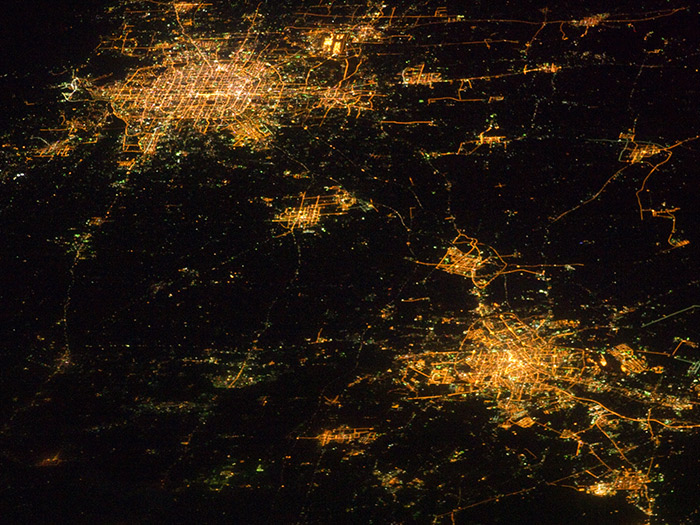 As the year turns, the astronauts in the International Space Station have been steadily circling the globe about 400 miles above us. A couple of nights ago, when they were flying over the ocean near North Korea, they picked up their little Nikon digital camera and pointed it westward, toward the Asian mainland. That's Beijing in the upper left, Tianjin in the lower right, glowing out into space.
As the year turns, the astronauts in the International Space Station have been steadily circling the globe about 400 miles above us. A couple of nights ago, when they were flying over the ocean near North Korea, they picked up their little Nikon digital camera and pointed it westward, toward the Asian mainland. That's Beijing in the upper left, Tianjin in the lower right, glowing out into space.
This is what new years will be looking like for a long time to come.
Meanwhile, may 2011 bring health and glowing good cheer to you and yours. This past year wasn't all that great; there is plenty of room for improvement.
Good mornings, y'all.
Feb 2, 2011
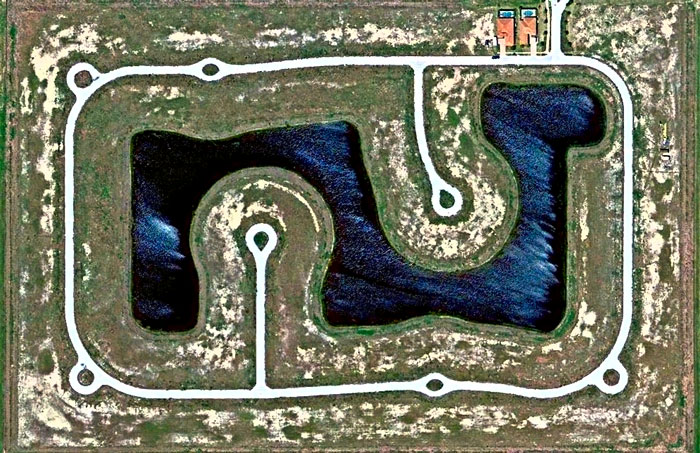 This is a picture of a real estate bubble. There have been land bubbles in Florida since forever; what we're looking at here is just the bubble du jour, a subdivision near Fort Myers, on the Gulf Coast, where the developer put in the roads and the "lake" and the cul de sacs and managed to build two houses complete with swimming pools before it was all over.
This is a picture of a real estate bubble. There have been land bubbles in Florida since forever; what we're looking at here is just the bubble du jour, a subdivision near Fort Myers, on the Gulf Coast, where the developer put in the roads and the "lake" and the cul de sacs and managed to build two houses complete with swimming pools before it was all over.
I read today that 11 per cent of the housing units in the United States are currently unoccupied. So it's really over. For a while.
May 13, 2011
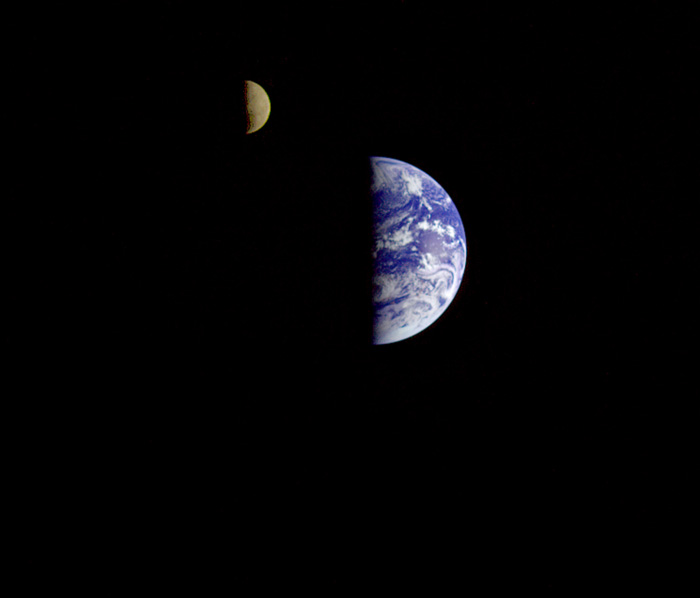 In 1977, the Voyager space probe shot this picture of the earth and moon together. It is believed to be the first snapshot that captures both bodies in the same frame.
In 1977, the Voyager space probe shot this picture of the earth and moon together. It is believed to be the first snapshot that captures both bodies in the same frame.
Jun 9, 2011
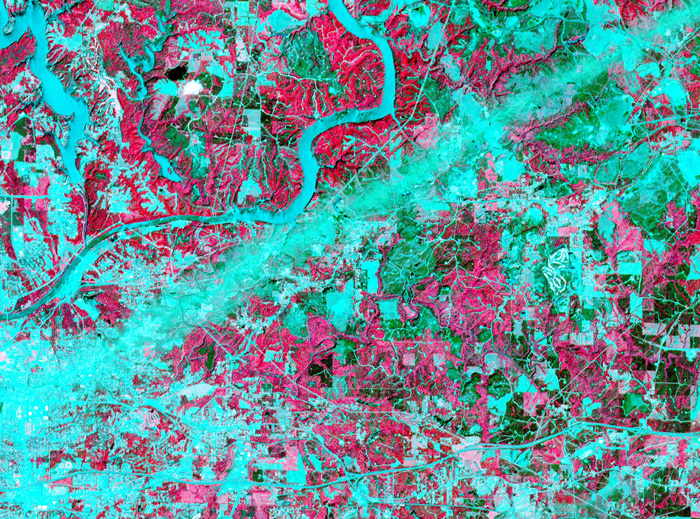 On April 28, 2011, the visible-light and infrared sensors of NASA's ASTER satellite captured this image of Tuscaloosa County, Alabama, which had been raked by an especially large and powerful tornado just the day before.
On April 28, 2011, the visible-light and infrared sensors of NASA's ASTER satellite captured this image of Tuscaloosa County, Alabama, which had been raked by an especially large and powerful tornado just the day before.
Infrared sensors are useful for distinguishing between vegetated and non-vegetated land cover. The pink areas in the photo represent vegetation–forests, pastures, cropland, golf courses. Areas that show up as aqua are non-vegetated or very lightly vegetated–cities, highways, rivers, strip mines, recent clearcuts.
The tornado track is obvious here: a straight aqua-colored streak running from the southwest to the northeast. Vegetation in this streak that was not directly destroyed by the storm was so littered with pieces of buildings and household objects that satellite sensors could barely detect it.
Just north of the storm track is the twisting course of the Black Warrior River, which shows up in aqua. The city of Tuscaloosa is mostly south of the river, at the left edge of the picture. In the upper left corner of the picture is Lake Tuscaloosa, a dammed-up tributary to the Black Warrior that provides the city's drinking water.
NASA's spokespeople assert that images such as this one can be useful in the aftermath of storms. They may help identify storm-damaged places outside of populated areas, where tornadoes might escape public awareness. And by proving the time and location of tornado paths, they could help homeowners support their insurance claims for storm damages.
If you click on the picture to see the larger version, you can follow numerous roads out into the countryside and observe that many of them seem to end with a little dot of aqua, indicating a non-vegetated spot. These are well pads for methane rigs. About fifteen years ago, the Black Warrior basin was the scene of one of the nation's first methane gas drilling booms. Coalfields underlie much of west Alabama, including almost all of Tuscaloosa County, but until recently the methane gas associated with coal deposits was considered a danger rather than an economically valuable fuel. "Fracking" technology, in which high-pressure liquids are injected deep into the earth to crack open the rocks hosting methane, was developed and refined in Alabama; drilling for methane is now under way all over the world. Unlike oil or traditional natural gas, methane is best extracted by small wells located within a few hundred feet of numerous other small wells; thus, the countryside is speckled with hundreds or thousands of separate well pads.
Jun 27, 2011
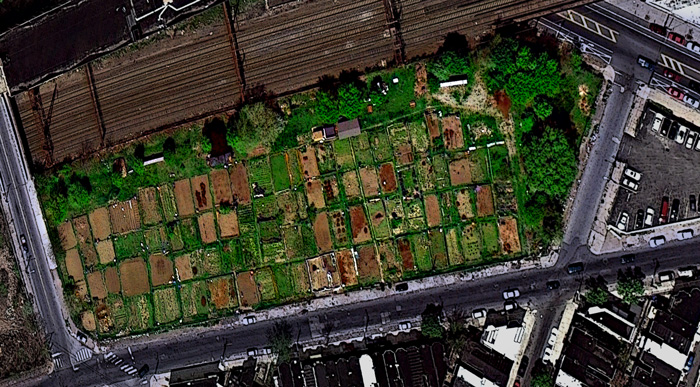 Glenwood Green Acres sits hard by the railroad tracks in north Philadelphia, on a strip of land where abandoned warehouses burned down in 1984. Ninety-six families in the neighborhood till plots in this community garden; some of them work at it full time, selling their produce or giving it to the hungry.
Glenwood Green Acres sits hard by the railroad tracks in north Philadelphia, on a strip of land where abandoned warehouses burned down in 1984. Ninety-six families in the neighborhood till plots in this community garden; some of them work at it full time, selling their produce or giving it to the hungry.
Their crops include: collard greens, peppers, eggplant, squash, string beans, okra, blackberries, cotton, and tobacco. The southern character of what is grown reflects the southern roots of many people in the north Philly neighborhoods surrounding Glenwood. People like to grow what they grew up growing.
Room to garden in is hard to come by in most of Philadelphia, where row houses line the streets with little or no yard space. There are community gardens all over town–an estimated 400 active ones–but most are tiny, typically occupying just a few hundred square feet in a vacant lot that the gardeners don't own and can't protect from development.
Glenwood is huge by comparison: 3.5 acres. And it's owned by a citywide land trust and operated by a neighborhood organization. The garden is deeded as public green space forever.
The number of vacant lots in the city is thought to be well over 30,000, and most of them are derelict. But after twenty years of struggling to purchase and protect land for Philadelphia's community gardens, the trust now owns just 22 parcels totaling less than 10 acres.
Meanwhile, for what it's worth, in my little one-pot garden, I have a golf-ball-sized tomato, plus 4 flowers on the plant and more buds than I can count. I'm so optimistic I'm not fit to be around.
Jul 10, 2011
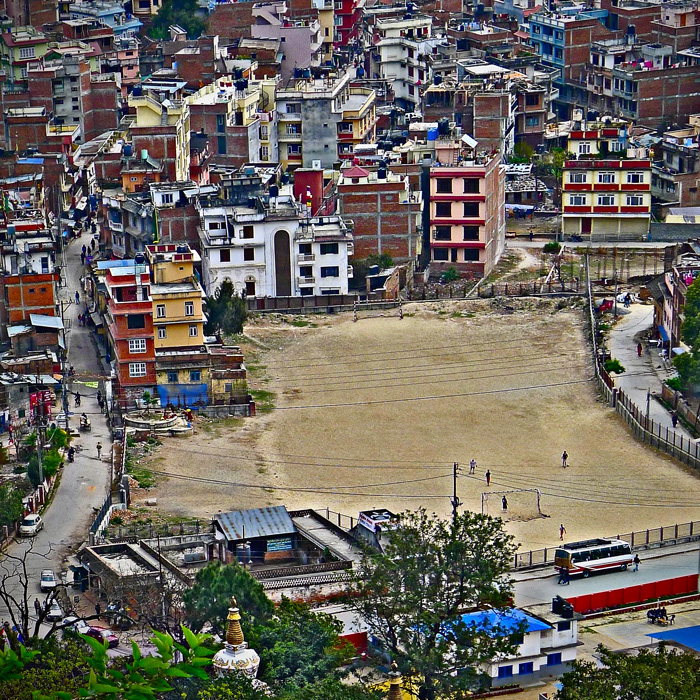 Soccer is popular in Nepal, even if the fields are more dirt than grass, and this year the national team, known as the Ghorkalis, is on a roll. Last week, Nepal notched two victories, 2-0 and then 5-0, in 2014 World Cup qualifying matches against East Timor. The Ghorkalis have a new coach, Graham Roberts, an Englishman who played for Tottenham and Chelsea, mostly on defense, and won six caps for England.
Soccer is popular in Nepal, even if the fields are more dirt than grass, and this year the national team, known as the Ghorkalis, is on a roll. Last week, Nepal notched two victories, 2-0 and then 5-0, in 2014 World Cup qualifying matches against East Timor. The Ghorkalis have a new coach, Graham Roberts, an Englishman who played for Tottenham and Chelsea, mostly on defense, and won six caps for England.
Meanwhile, in league play, defending champions Nepal Police Club holds a comfortable lead in the Martyrs Memorial Red Bull Division A, though Yeti Air Himalayan Sherpas Club is not out of the running.
The field shown here is in the suburbs of Kathmandu, at the base of the hill topped by the Monkey Temple.
Jul 9, 2011
 About three weeks ago, the Nabro volcano in the East African nation of Eritrea began erupting for the first time in recorded human history. The initial eruption was a violent explosion, pumping vast quanitities of ash and sulfur dioxide into the air above North Africa and the Middle East. Aviation in the region was briefly suspended. Nabro's dark, dense plume of ash and gases shrouded the mountaintop for two weeks, concealing the eruption from view until June 29, when this satellite image was captured.
About three weeks ago, the Nabro volcano in the East African nation of Eritrea began erupting for the first time in recorded human history. The initial eruption was a violent explosion, pumping vast quanitities of ash and sulfur dioxide into the air above North Africa and the Middle East. Aviation in the region was briefly suspended. Nabro's dark, dense plume of ash and gases shrouded the mountaintop for two weeks, concealing the eruption from view until June 29, when this satellite image was captured.
The image shows that the eruption has transitioned to a quieter, oozing sort of phase. Hot lava glows orange, fading to black as it cools. The lobes at the end of the long lava flow are dark, suggesting that the top of the flow may have crusted over. As the long westward flow cools, hotter, fresher lava appears to be spilling out of the vent toward the south and east.
Nabro is in very arid, dusty country; the green patches in the landscape around the volcano are actually only sparsely vegetated. The image was captured using a combination of infrared and visible light, which misrepresents the degree of vegetation in the landscape.
Although the eruption is a first for the record books, Nabro is in the East African rift valley, where volcanic activity in one form or another is nearly constant. Three tectonic plates are pulling apart from one another in this region, stretching the earth's crust so thin that hot magma from deep below finds numerous weak spots through which to erupt.
Aug 11, 2011
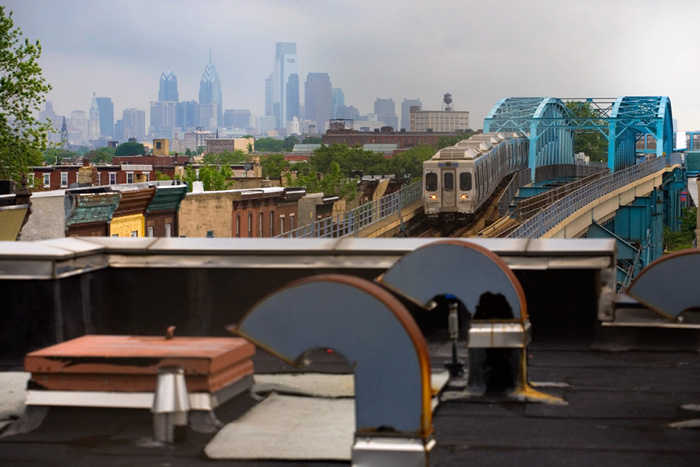 In recent years, gentrification in many Philadelphia neighborhoods has been characterized by construction of new rooftop decks on top of old rowhouses. This view is from a rooftop elevated above the elevated train in the Kensington neighborhood; the rooftop has not yet been completely deckified, but the view is as good as it's going to get.
In recent years, gentrification in many Philadelphia neighborhoods has been characterized by construction of new rooftop decks on top of old rowhouses. This view is from a rooftop elevated above the elevated train in the Kensington neighborhood; the rooftop has not yet been completely deckified, but the view is as good as it's going to get.
Aug 16, 2011
 "Lee, Brian & Jeff making dinner," notes photographer Rich Durant, who snapped the picture of the men at their campsite along the Lorillard River in Nunavut. The Lorillard flows across tundra and bare rock of the billion-year-old Canadian Shield to enter Hudson Bay near the latitude of the Arctic Circle.
"Lee, Brian & Jeff making dinner," notes photographer Rich Durant, who snapped the picture of the men at their campsite along the Lorillard River in Nunavut. The Lorillard flows across tundra and bare rock of the billion-year-old Canadian Shield to enter Hudson Bay near the latitude of the Arctic Circle.
Where was Rich standing when he took this shot? It doesn't really matter; he had flown the camera up into the sky by hanging it from a kite and was using a remote control mechanism to operate the shutter while remaining safely on the ground.
The men were canoeing down the whitewater of the Lorillard; as you can see, they had stowed their gear in drysacks and waterproof boxes. The sacks and boxes don't look particularly bear-proof, however, and it's not clear what kind of arrangements they might be making to keep their food away from bears and other critters.
Whatever they were doing, it apparently didn't work out too well. The pictorial record of the expedition–called "Lorillard River Briefly"–includes photos (taken from the ground) of wolf tracks and big white bears, and then . . . a tent and foodsack trashed by something big and hungry.
Aug 19, 2011
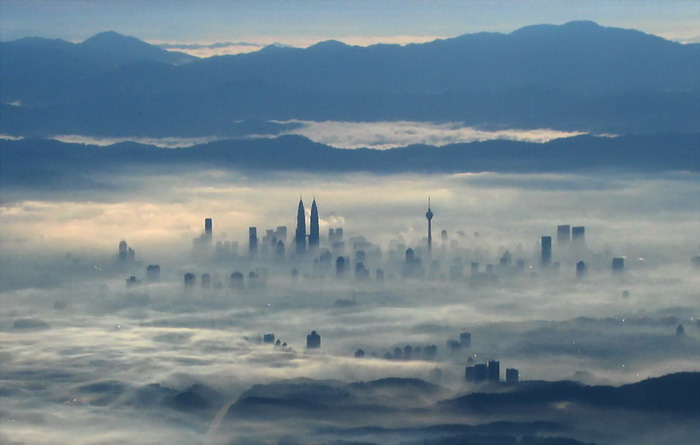 Kuala Lumpur, Malaysia, from 30,000 feet.
Kuala Lumpur, Malaysia, from 30,000 feet.
Sep 9, 2011
 Way, way out in the country, a million miles away from city lights, on a clear night the sky is lit by stars, as we see above at left, in a photo taken in Glacier National Park in Montana. The few small clouds in this starlit sky show up as black blotches that block some of the stars; a completely cloudy night in remote parts of the world is a very, very dark night, too dark to photograph at all.
Way, way out in the country, a million miles away from city lights, on a clear night the sky is lit by stars, as we see above at left, in a photo taken in Glacier National Park in Montana. The few small clouds in this starlit sky show up as black blotches that block some of the stars; a completely cloudy night in remote parts of the world is a very, very dark night, too dark to photograph at all.
In the megalopolis, however, clouds actually light up the sky by reflecting urban light pollution to brighten the night dramatically; an overcast night in a big city like Berlin, shown above at right, can be up to ten times brighter than a clear night.
Sep 16, 2011
(Image removed at the request of the photographer, Cris Benton)
This view of Drake's Beach at Point Reyes National Seashore in California is another example of kite photography, one of the oldest applications of the photo arts.
During the American Civil War, kites and balloons were used to hoist cameras, and sometimes also cameramen, for spying expeditions. Kite photography was also used to survey the damage after San Francisco's 1906 earthquake and fire.
Planes and satellites, of course, have relegated kite photography to niche status. On the other hand, modern digital cameras and wireless control technology have become so lightweight and inexpensive that it's a readily accessible niche.
Sep 27, 2011
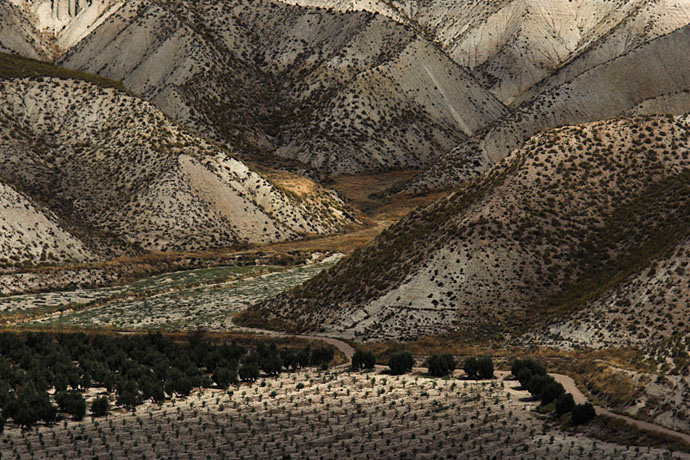 Polish photographer Marcin Sacha has recently added the landscapes of Andalusia, Spain, to the range of scenes in his portfolio.
Polish photographer Marcin Sacha has recently added the landscapes of Andalusia, Spain, to the range of scenes in his portfolio.
Sep 29, 2011
 A couple of weeks ago, when the International Space Center was looping around the southern part of the globe, heading toward Antarctica from Australia, astronauts used the little digital camera on board to snap this picture.
A couple of weeks ago, when the International Space Center was looping around the southern part of the globe, heading toward Antarctica from Australia, astronauts used the little digital camera on board to snap this picture.
The fires were intentionally set by farmers clearing fields or pastures to make way for spring growth. The green horizon is the Aurora Australis, bright pulses of electromagnetic energy released when solar pulses are deflected toward the earth's southern magnetic pole. Green is the most common color of auroras, produced when solar energy disrupts the normal spinning of oxygen molecules in the upper atmosphere; auroras can also be red, pink, or orange, depending on the atmospheric gases involved.
The space station itself is visible across the top of this photo and in the lower right corner.
Oct 6, 2011
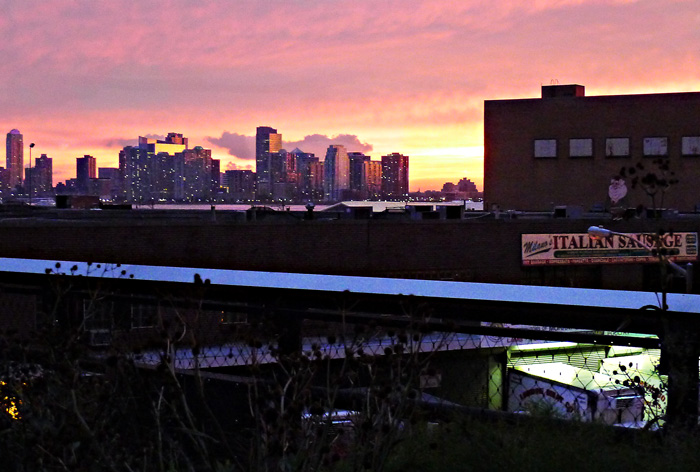 As the sun sets over New Jersey, the Milano's Italian Sausage trucks begin their nightly rounds in Manhattan.
As the sun sets over New Jersey, the Milano's Italian Sausage trucks begin their nightly rounds in Manhattan.
New York City's new High Line Park repurposes an old elevated railroad track along the west side of lower Manhattan for strolling and people-watching high above the bustle of downtown streets. Trees and flowers grow out of the old track bed, blooming between the ties, while in the distance is the river, the skyscrapers, the restaurants and nightclubs, and, along this stretch of the route, the warehouses of the old meatpacking district.
Dec 1, 2011
 At about 9:30 in the morning on September 23, 1999, the Landsat 7 satellite swooped southward over eastern North America and captured this image of Philadelphia and environs.
At about 9:30 in the morning on September 23, 1999, the Landsat 7 satellite swooped southward over eastern North America and captured this image of Philadelphia and environs.
Three of the Landsat sensors detected energy in the infrared part of the electromagnetic spectrum, completely invisible to the human eye. Data from these sensors is displayed here, with each of the three infrared bands assigned to one of the normal red-green-blue color bands so we at least have something to look at, even though the colors have nothing to do with normal vision.
Clicking on the picture brings up a bigger version, which shows much more detail.
We can tell right away that the rivers are black; infrared energy is completely absorbed by water, reflecting back nothing for the sensors to detect. And if we look along the river at lower left, we can make out the airport, with runways that are bright cyan in color. This white-to-bluish hue is also the color of roads, railroads, parking lots, and other paved surfaces.
Infrared data is especially useful for studying vegetation, which shows up in this color scheme as red, orange, or yellow. The brightest red patches represent vigorous herbaceous growth, such as healthy cropland in the midst of the growing season. There's little or no farmland in and around Philly, however, so the red patches we see here, such as in between the airport runways, are probably healthy weeds.
Patches of red coloration with a touch of an orange tint and some texture are forested areas, such as in parks or between the fairways of golf courses. Extremely vigorous grass, such as on the golf course fairways themselves, looks bright yellow in this view.
The brownish-to-grayish-to-bluish areas show mixed land cover: Landsat's sensors are averaging out the infrared signals from house roofs, pavement, lawns, shrubs, and trees in varying concentrations. Brownish areas are suburban, with lots of trees and grass; dark green to gray-blue areas are more urban, with a higher ratio of rooftops and pavement to vegetation.
Philadelphia has changed since this image was captured twelve years ago. Another stadium has been built near where the Schuylkill River empties out into the Delaware. In my neighborhood just south of Center City, the forested patch of land near the Schuylkill, which in 1999 was an abandoned and overgrown Old Sailors' Home is now a heavily developed condo complex. Even though the population of Philadelphia has shrunk dramatically over the past half-century and has just barely started growing again, land use patterns as viewed from outer space show ongoing urbanization.
Dec 9, 2011
The satellite view of Philadelphia in infrared, from a few days ago, led some people to ask for more false-color imagery of our planet. Here we've got a river delta in the tundra of eastern Siberia, where the River Lena empties into the Arctic Ocean. The image is from mid-summer, when the plants of the tundra were bursting with new growth, thanks to twenty-four hours a day of sunlight. The color scheme here is different from that of the Philadelphia scene but still not closely related to the colors a human eye would detect. The data displayed comes from three sensors on the Landsat satellite: one that detects infrared energy, another that detects near-infrared energy, which is very sensitive to the chemicals associated with growing vegetation, and a third sensor that picks up a part of the visible spectrum. Vegetation is green, exposed rock or soil is pink, wet soil (mud) is purple, and ice is blue.
Even in mid-summer, the sea ice floats close to shore. It will take another month or two for most of the ice to melt and/or wash out to sea, but as soon as it does freezing temperatures will return and ice formation will begin again.
The innumerable ponds and distributary streams are typical of flat places throughout the Arctic tundra, where permafrost just below the surface impairs drainage. Meltwater and rainwater sit on top of the permafrost all summer long, breeding mosquitoes...... which don't show up in the satellite imagery.
Jan 3, 2012
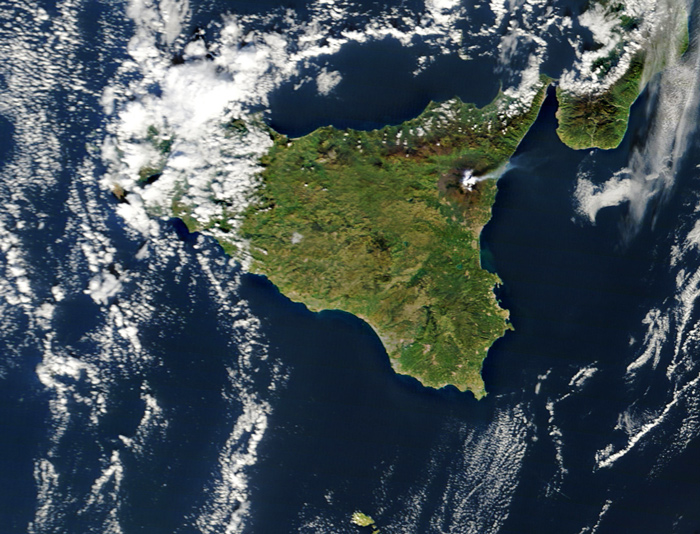 Right around this time last year, Mt. Etna in Sicily started doing this. Again.
Right around this time last year, Mt. Etna in Sicily started doing this. Again.
Jan 5, 2012
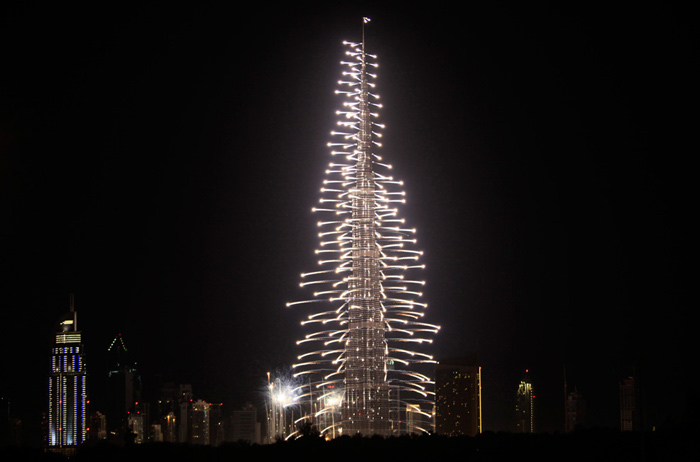 At the world's tallest office building, they had fireworks for New Year's.
At the world's tallest office building, they had fireworks for New Year's.
Feb 17, 2012
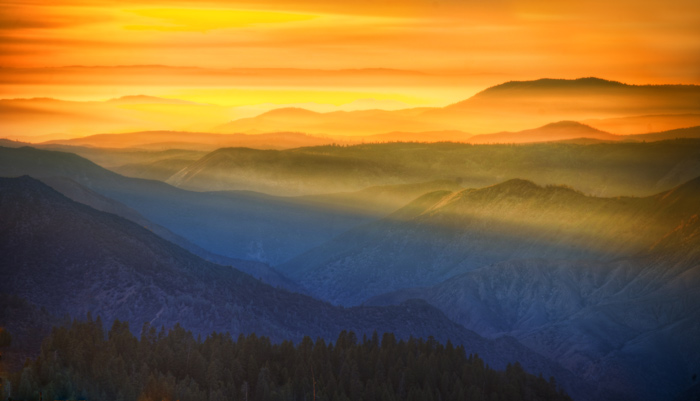 The sun sank in the west, and then it was dark in Yosemite Valley.
The sun sank in the west, and then it was dark in Yosemite Valley.
Feb 26, 2012
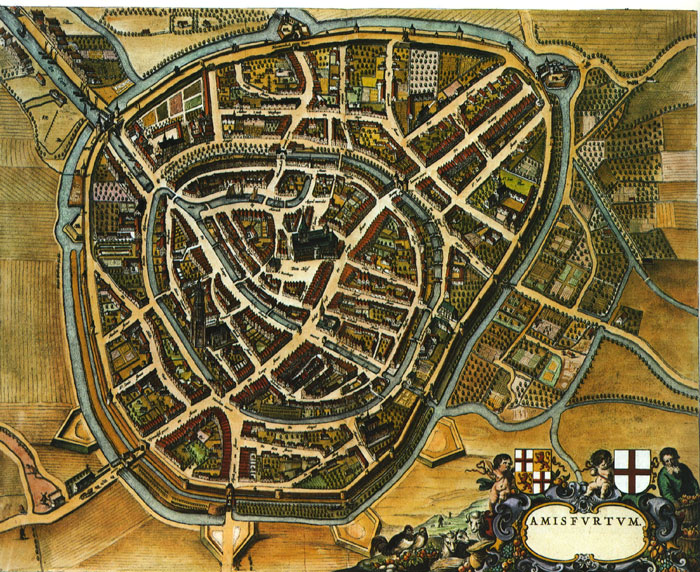 This was Amersfoort, Netherlands, back in the day. The city has since grown to 24 square miles, with a population of almost 150,000, but its medieval center is said to be well preserved and legally protected. Known as Boulder City, Amersfoort is now 753 years old.
This was Amersfoort, Netherlands, back in the day. The city has since grown to 24 square miles, with a population of almost 150,000, but its medieval center is said to be well preserved and legally protected. Known as Boulder City, Amersfoort is now 753 years old.
The Netherlands doesn't have very many boulders, but there used to be a big one, weighing more than nine tons, out on the moors south of town. In 1661, however, a couple of Amersfoort's leading citizens got to drinking and wagering, and then wouldn't you know it, one of them rounded up 400 neighbors to push the rock into the center of town.
The rock-pushers were rewarded with beer and pretzels, but Amersfoortians soon discovered that they really didn't much like being known far and wide as boulder draggers. They didn't like that their city's reputation was all about the stupid rock in the main square. In 1672, they buried the boulder.
More than two centuries later, in 1903, the buried rock was rediscovered and again put on display. Pranksters have moved it again from time to time, presumably with heavy equipment, but the city has now mounted its nine-ton token high on a pedestal for all the world to see.
Mar 8, 2012
 The desert of northern Saudi Arabia is among the most barren places on earth. But beginning in 1986, when water wells were drilled into deep aquifers, vast stretches of desert land have been irrigated for agricultural use. So much of Saudi Arabia is now farmland that the fields are visible from space, as shown here in this photo taken last week by astronauts on the International Space Station. The circular fields are each about one kilometer in diameter.
The desert of northern Saudi Arabia is among the most barren places on earth. But beginning in 1986, when water wells were drilled into deep aquifers, vast stretches of desert land have been irrigated for agricultural use. So much of Saudi Arabia is now farmland that the fields are visible from space, as shown here in this photo taken last week by astronauts on the International Space Station. The circular fields are each about one kilometer in diameter.
This is energy-intensive agriculture; it takes a lot of fossil fuel to pump water from so deep underground and to operate the center-pivot irrigation systems that keep the wheat fields and vegetable patches green despite bone-dry desert air. But Saudi Arabia has a lot of fossil fuel, and its desert agriculture is expanding rapidly.
(The water in the aquifers is itself fossilized, left over from the Ice Age, before this part of the world became so hot and arid.)
Mar 21, 2012
Apr 13, 2012
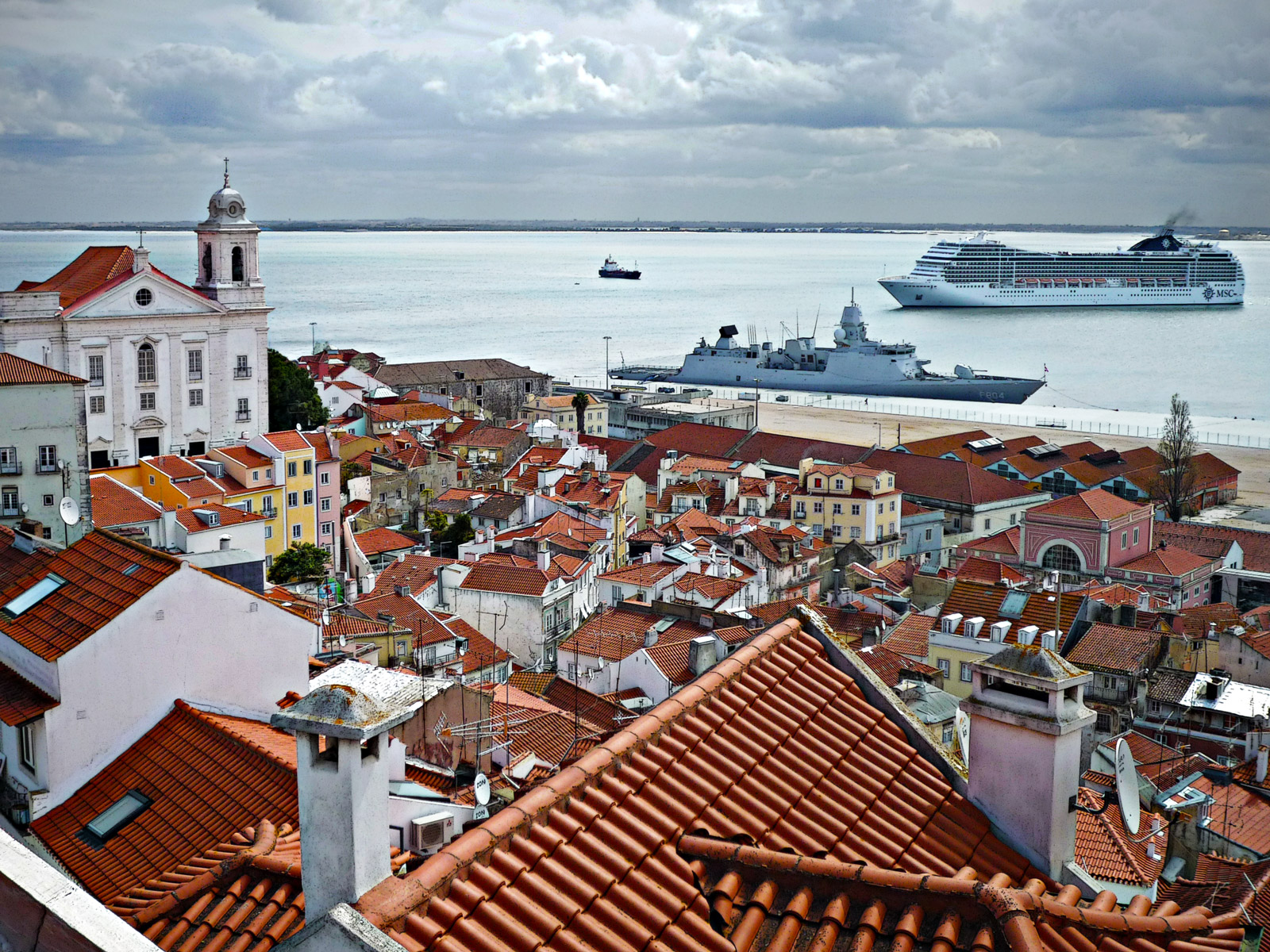 Above the ships at sea and Lisbon's red tile roofs and satellite dishes.
Above the ships at sea and Lisbon's red tile roofs and satellite dishes.
Jun 1, 2012
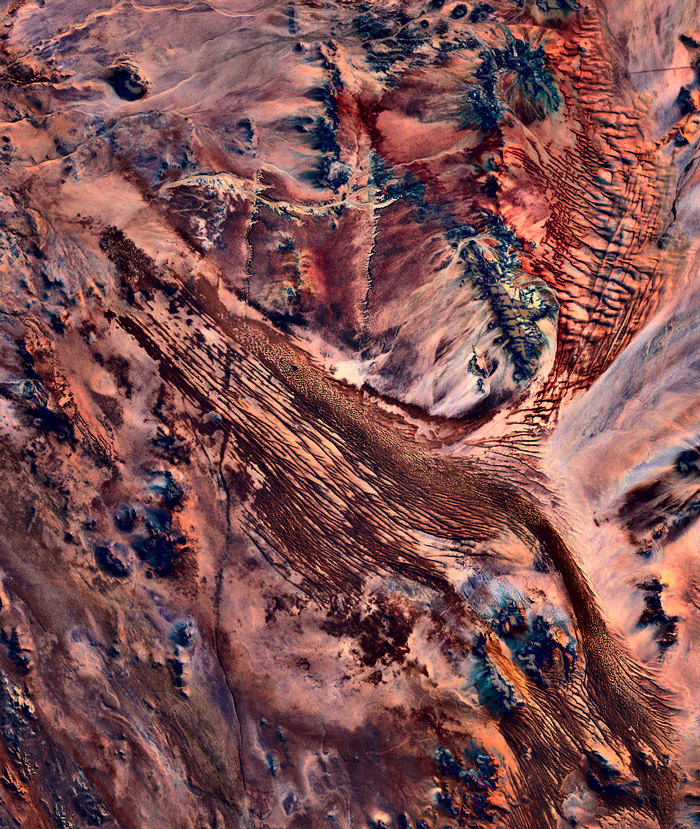 Southern Namibia, as seen from the Landsat 7 satellite orbiting 700 kilometers above the earth's surface.
Southern Namibia, as seen from the Landsat 7 satellite orbiting 700 kilometers above the earth's surface.
Jun 4, 2012
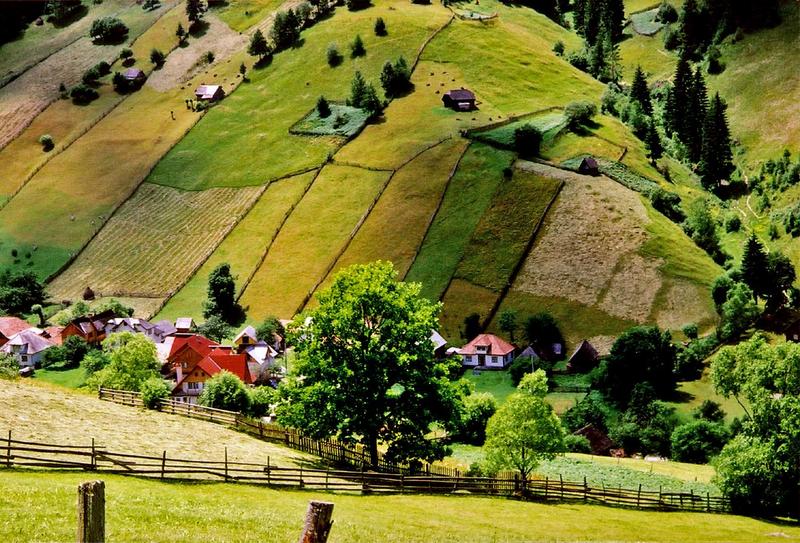 "Somewhere in Transylvania," according to the photographer, who offers up only two facts about himself by way of identification: he lives in the city of Arad in western Romania, and he likes Johnny Cash and Frank Sinatra.
"Somewhere in Transylvania," according to the photographer, who offers up only two facts about himself by way of identification: he lives in the city of Arad in western Romania, and he likes Johnny Cash and Frank Sinatra.
Aug 12, 2012
 A peregrine falcon takes in a February sunrise from the railing of an apartment balcony in Chicago.
A peregrine falcon takes in a February sunrise from the railing of an apartment balcony in Chicago.
Oct 29, 2012
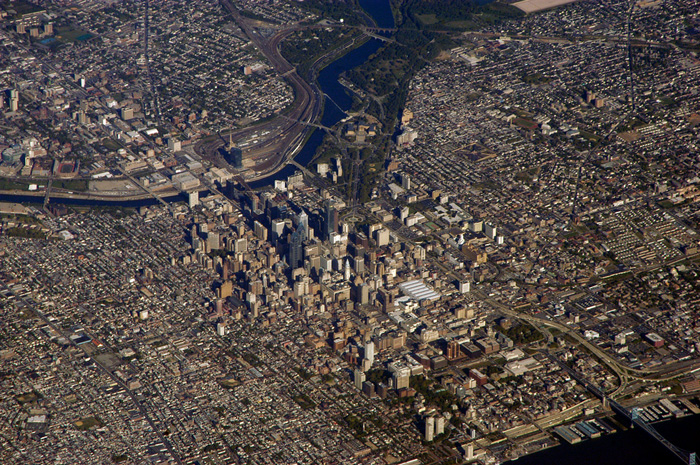 Is there some kind of bullseye painted across the rooftops of Philadelphia? We are told that this Hurricane Sandy storm-creature is aiming straight at us and will not rest till it rakes us with its cold, cold eye.
Is there some kind of bullseye painted across the rooftops of Philadelphia? We are told that this Hurricane Sandy storm-creature is aiming straight at us and will not rest till it rakes us with its cold, cold eye.
Until further notice then: to find my house, start from the bridge closest to the lefthand edge of the picture and trace about six blocks along the streets that angle downard and toward the right. Amongst all the rowhouses of the neighborhood, you may be able to make out a larger orange building with a dark roof; that's a church known as Apostolic Square, just a block and a half from our house.
Although both the rivers seen here are technically tidal–at least as far upstream as the dam near the art museum in the parkland above the center of the photo–the city is far inland and is not likely to get much storm surge. And it appears we won't be eligible for any of the snow this time. But school and garbage pickup have already been canceled, and there's rain on the roof.
Nov 19, 2012
 From the rooftops, here on Kater Street, you can see most of Philadelphia's gap-toothed skyline, such as it is. This is a city that had no tall skyscrapers at all until the late 1980s and does not yet have a critical mass of them, skyline-wise.
From the rooftops, here on Kater Street, you can see most of Philadelphia's gap-toothed skyline, such as it is. This is a city that had no tall skyscrapers at all until the late 1980s and does not yet have a critical mass of them, skyline-wise.
From a few fortunate vantage points around town, the buildings of Center City appear to clump together more or less like a proper downtown. But from most places, including the roofs of Kater Street's two-story row houses, the skyline looks raggedy and disorganized.
Actually, from the roof of our own house up toward the end of the block, you can't see the skyline at all on account of the trees–or at least that was the case last week, when we climbed up there and shot this picture. Since then, the leaves have yellowed and dropped quite suddenly, and we would imagine the view is now only partially blocked, by a lacework of tree branches.
Nov 28, 2012
 It does seem like we don't make anything in America any more, but that's not completely true. Right here under this roof in Easton, Pennsylvania, Americans make Crayola crayons and . . . Silly Putty. Not only that, but up the road a few miles they've got a factory outlet store and a Crayola Discovery Center, which is basically a crayon-themed theme park.
It does seem like we don't make anything in America any more, but that's not completely true. Right here under this roof in Easton, Pennsylvania, Americans make Crayola crayons and . . . Silly Putty. Not only that, but up the road a few miles they've got a factory outlet store and a Crayola Discovery Center, which is basically a crayon-themed theme park.
Still and all, this factory doesn't look quite right. You can't make a lot of crayons without heating up a lot of wax–shouldn't they have some serious smokestacks here?
Feb 4, 2013
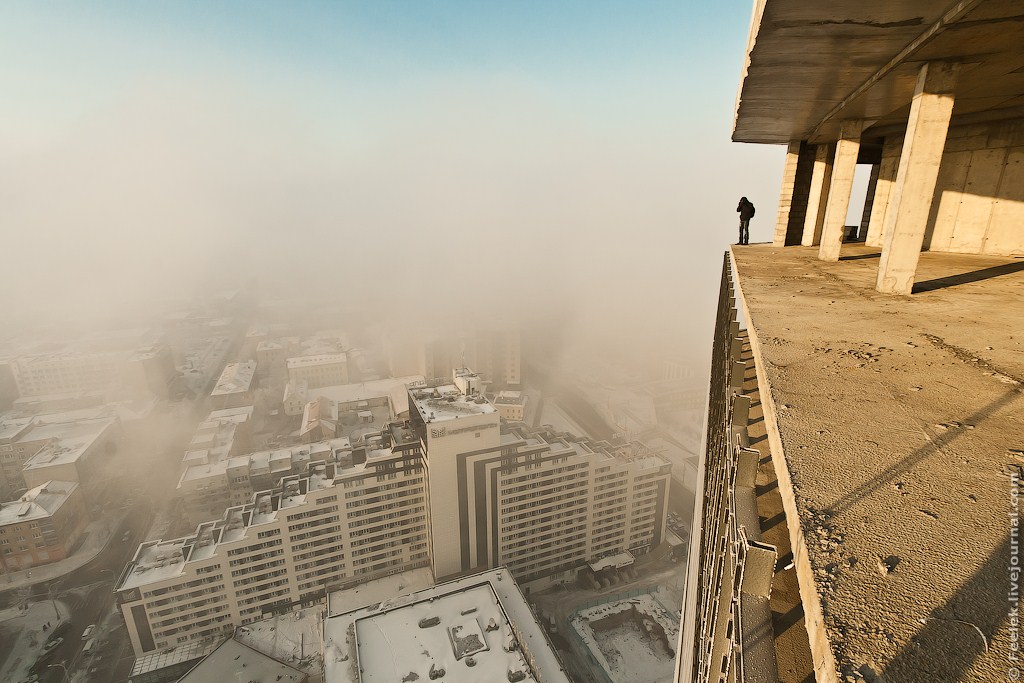 Grand prize winner from the 2012 international SkyscraperCity photo competition.
Grand prize winner from the 2012 international SkyscraperCity photo competition.
Meanwhile, here in Pennsylvania, Punxatawney Phil saw his shadow, foreshadowing an early spring, and the winter weather continues to compare favorably to the conditions suggested in the photo.